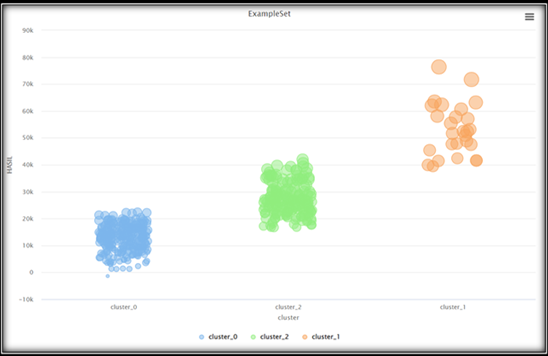Main Article Content
Abstract
The purpose of this study is to implement the K-Means Clustering method to determine the patterns of productive oil palm production based on their blocks at Pt Arta Prigel. The research is motivated by issues within the oil palm blocks, such as the absence of productive block summaries, insufficient plantation land analysis, and erroneous decision-making. The development method utilizes CRISP-DM, with data spanning 2 years from October 2021 to October 2023. From the 1275 production records, after cleaning, 1015 records remain. Filtering the initial 51 blocks results in 37 blocks for the years 2021 and 2022, and 46 blocks for the year 2023. After clustering, the production outcomes for the year 2021 are as follows: cluster_0 has 34 blocks, cluster_1 has 2 blocks, and cluster_2 has 10 blocks. For the year 2022, cluster_0 has 36 blocks, cluster_1 has 8 blocks, and cluster_2 has 28 blocks. In the year 2023, cluster_0 has 39 blocks, cluster_1 has 8 blocks, and cluster_2 has 33 blocks. The testing method employs the silhouette coefficient, and the silhouette score testing results indicate the formation of 3 clusters (K=3) with a value of 0.61. The findings of this study include patterns, graphs, and production tables generated using the K-Means Clustering method at Pt Arta Prigel.
Keywords
Article Details

This work is licensed under a Creative Commons Attribution-NonCommercial 4.0 International License.
References
- P. Amita Tri Prasasti and C. Dewi, “Pengembangan Assesment of Inovation Learning Berbasis Revolusi Industri 4.0. untuk Guru Sekolah Dasar,” J. Ilm. Sekol. Dasar, vol. 4, no. 1, p. 66, 2020, doi: 10.23887/jisd.v4i1.24280.
- R. I. O. Limabri, F. Putrawansyah, and A. Arif, “Penerapan Data Mining Untuk Mengklasifikasi Nasabah Bank Sumsel Babel Menggunakan Algoritma C4. 5,” Escaf, pp. 1101–1108, 2023.
- P. Alkhairi and A. P. Windarto, “Penerapan K-Means Cluster Pada Daerah Potensi Pertanian Karet Produktif di Sumatera Utara,” pp. 762–767, 2019.
- & Z. 2021 Zulfa, Auliya, Permata, “Analisis Data Mining Untuk Clustering Kasus COVID-19 di Provinsi Lampung Dengan Algoritma K-Means,” vol. 2, no. 2, pp. 100–108, 2021.
- F. Febriansyah and S. Muntari, “Penerapan Algoritma K-Means untuk Klasterisasi Penduduk Miskin pada Kota Pagar Alam,” vol. 8, no. 1, pp. 66–77, 2023.
- M. R. Nahjan, N. Heryana, A. Voutama, F. I. Komputer, U. S. Karawang, and R. Miner, “Implementasi Rapidminer Dengan Metode Clustering K-Means Untuk Analisa Penjualan Pada Toko Oj Cell,” vol. 7, no. 1, pp. 101–104, 2023.
- S. Rokhanah, A. Hermawan, and D. Avianto, “Pengaruh Principal Component Analysis Pada Naïve Bayes dan K-Nearest Neighbor Untuk Prediksi Dini Diabetes Melitus Menggunakan Rapidminer,” vol. 11, no. 1, 2023.
- K. Ademariana, F. R. Lumbanraja, and R. Andrian, “Jurnal Pepadun Clustering K-Means Jenis Kata Pada Laporan Kegiatan Kuliah Kerja Nyata ( KKN ) Universitas Lampung Menggunakan Word2vec © 2021 Ilmu Komputer Unila Publishing Network all rights reserved Jurnal Pepadun,” vol. 3, no. 2, pp. 221–228, 2021.
- M. Astiningrum, M. Mentari, and Y. G. Maranatha, “Mutu Buah Salak Menggunakan Pengolahan Citra Digital,” pp. 205–210.
- N. Afdhaliah, “Perbandingan kinerja algoritma ward dan algoritma k-means dengan uji silhouette coefficient,” 2020.
- F. N. Dhewayani, D. Amelia, D. N. Alifah, B. N. Sari, and M. Jajuli, “Implementasi K-Means Clustering untuk Pengelompokkan Daerah Rawan Bencana Kebakaran Menggunakan Model CRISP-DM,” vol. 12, no. 1, pp. 64–77, 2022, doi: 10.34010/jati.v12i1.6674.
- I. M. Pulungan, M. Fauzan, and A. P. Windarto, “Implementasi Algoritma K-Means Clustering dalam Menentukan Blok Tanaman Sawit Paling Produktif,” no. September, pp. 338–348, 2019.
- B. Ginting and F. Riandari, “Implementasi Metode K-Means Clustering Dalam Pengelompokan Bibit Tanaman Kopi Arabika,” vol. 3, no. 2, pp. 151–157, 2020.
- A. K-means, “Klastering Sayuran Unggulan Menggunakan Clustering of Featured Vegetables Using the K-Means Algorithm,” vol. 8, pp. 567–579, 2022.
- Budiman and T. Parama Yoga, “Optimalisasi K-Means Berbasis Particle Swarm Optimization untuk Hasil Produksi Tanaman Sayuran di Indonesia,” J. Nuansa Inform., vol. 17, pp. 2614–5405, 2023.
- M. A. Hasanah, S. Soim, and A. S. Handayani, “Implementasi CRISP-DM Model Menggunakan Metode Decision Tree dengan Algoritma CART untuk Prediksi Curah Hujan Berpotensi Banjir,” vol. 5, no. 2, 2021.

